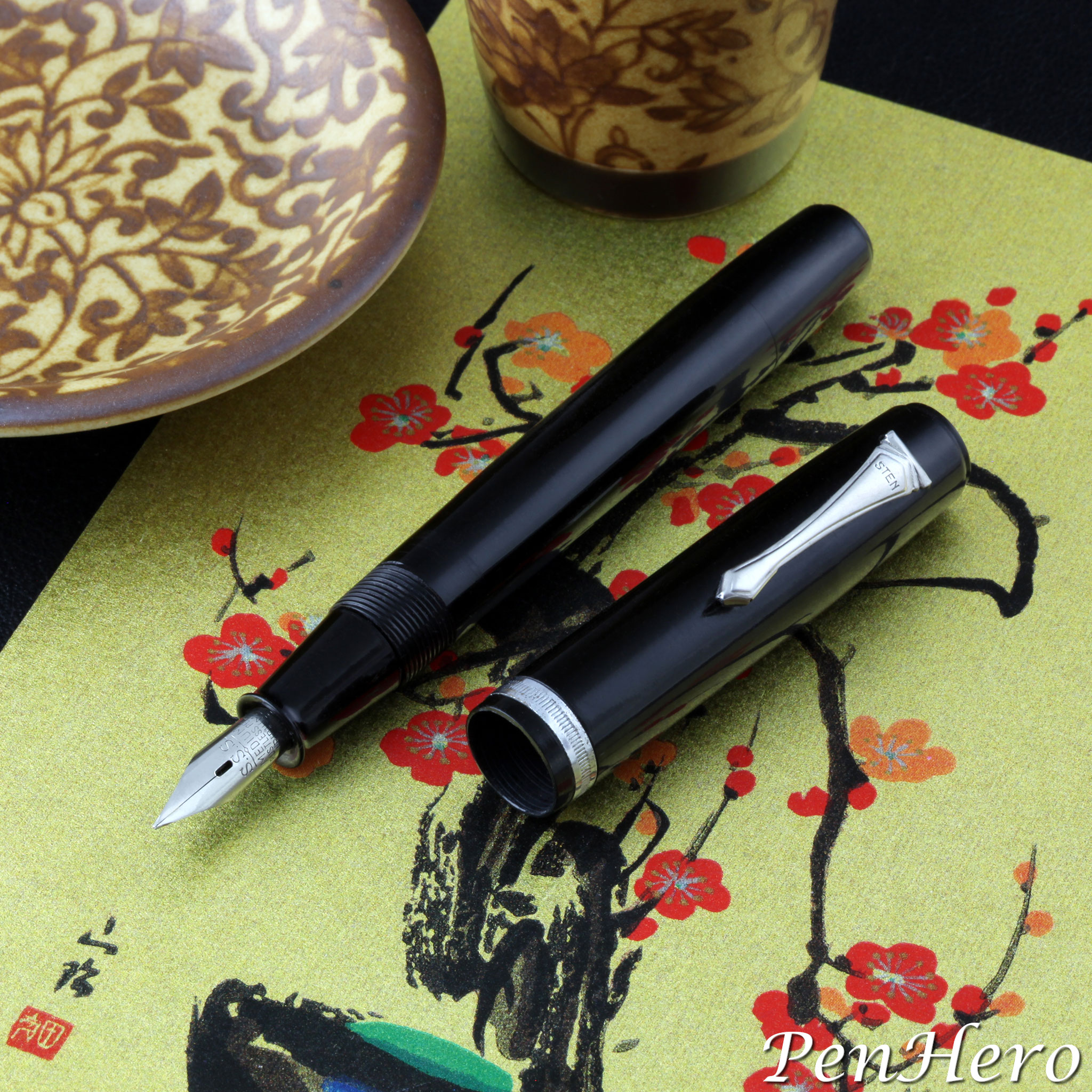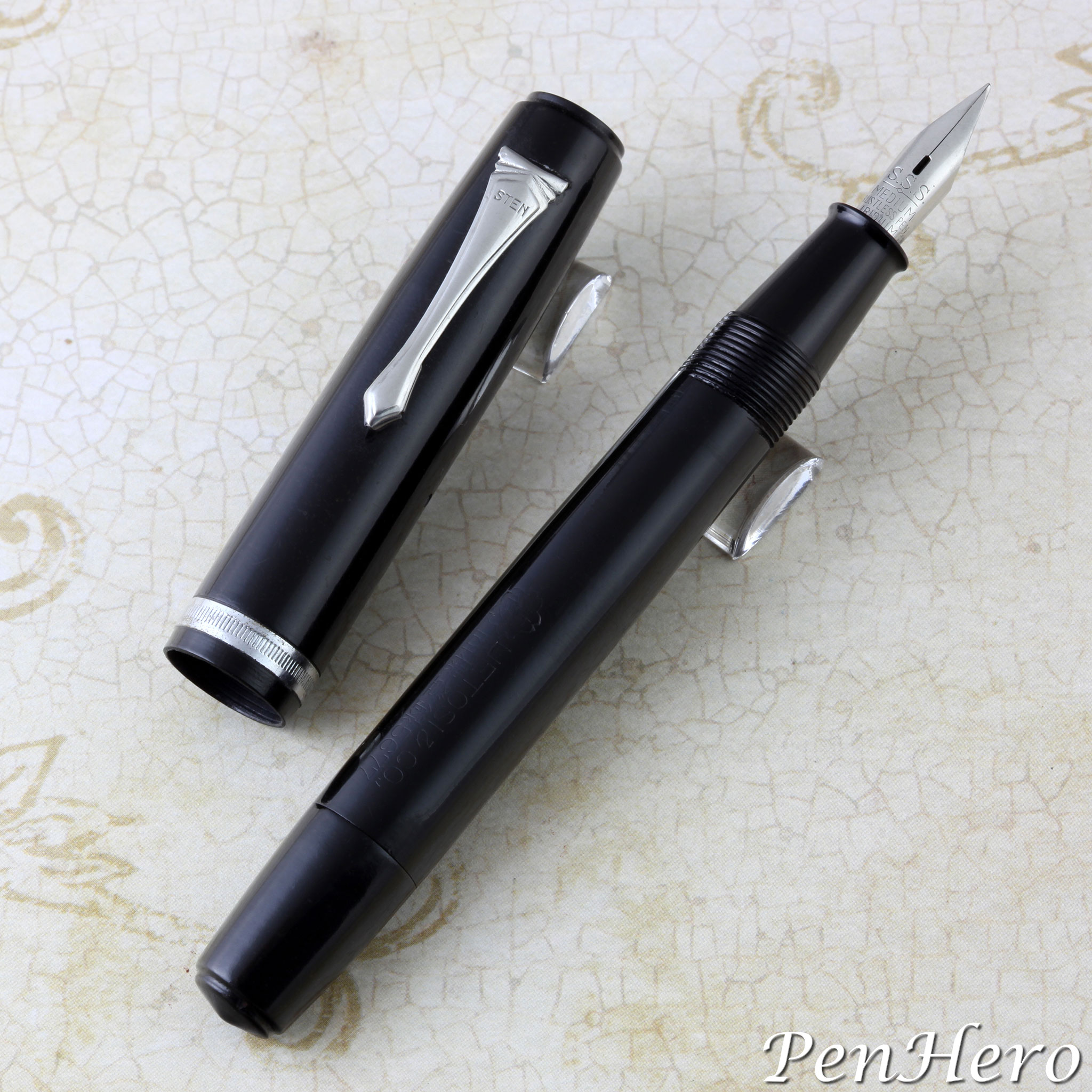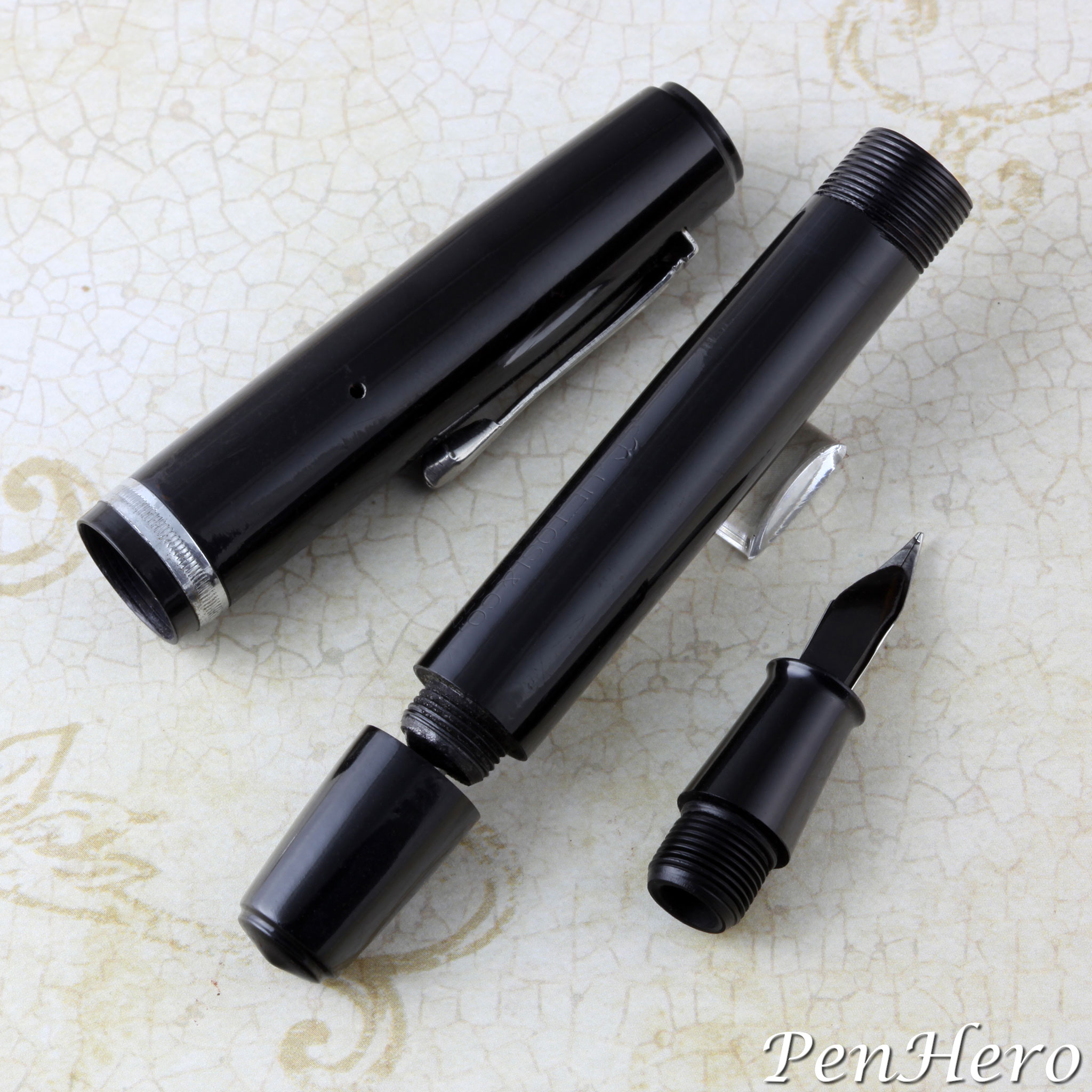Uetosi Ink Shut-Off Eyedropper Fountain Pen With S.S.S. Nib c. 1938 to 1952
by Jim Mamoulides, April 18, 2025
 Uetosi ink shut-off eyedropper fountain pen with S.S.S. nib c. 1938 to 1952
Uetosi ink shut-off eyedropper fountain pen with S.S.S. nib c. 1938 to 1952
Two stories in one pen
A few years ago, when pen hunting in Maine, we ran across an antique store with a lot of very unusual pens, including several Japanese eyedropper pens that have a shut-off knob at the end of the barrel. This black hard rubber fountain pen, similar to many from the late 1930s to the early 1950s, has a very interesting imprint stamped on the barrel. Left to right it begins with a chrysanthemum outline logo and then there are two text lines, the top in English and the bottom in Japanese characters. The top line is UETOSI & CO. "Uetoshi" translates to "top," so perhaps the brand translates to "Top (Fountain Pen) & Co." The bottom line is Japanese kanji characters that roughly translate to “record number 5677.” Perhaps that is a model number. It’s too short for a patent.
The design copies the look of late 1930s to early 1950s Pilot fountain pens, with a nearly identical cap and barrel shape, clip design, single cap band, and nickel plated trim. Where the Pilot pens have a plain cap band, this band has a coin edge center. The clip is stamped STEN and is probably from a pen parts company. What “STEN” stands for is unknown. It's a fairly large pen at 5 3/8 inches long.
 Uetosi ink shut-off eyedropper fountain pen with S.S.S. nib c. 1938 to 1952
Uetosi ink shut-off eyedropper fountain pen with S.S.S. nib c. 1938 to 1952
Uetosi is very likely one of the many small pen makers that turned caps and barrels and outfitted them with hardware bought from pen parts companies. Some of the very smallest companies did not make or have made their own branded nibs or clips. It could be in this case the buyer selected a nib and had it fitted by the pen seller.
Uetosi did make pens with their brand name on the clip at least in the 1950s, with the same chrysanthemum outline logo stamped at the top of the clip and the company name down the face. I’ve only seen a couple of these pens but have not seen one with an Uetosi nib, so they may have ordinarily installed generic nibs on their pens. I just don't know.
 Uetosi ink shut-off eyedropper fountain pen with S.S.S. nib c. 1938 to 1952
Uetosi ink shut-off eyedropper fountain pen with S.S.S. nib c. 1938 to 1952
It’s an eyedropper filling pen with an ink shut-off knob at the end of the barrel. These pens fill by unscrewing the nib section and dripping ink into the barrel using a long eyedropper. The knob at the end of the barrel is attached to a long rod that extends inside the barrel up to the base of the feed in the nib section. When the knob is screwed flush with the end of the barrel, the rod cuts off ink flow to the feed, making it an ink shut off valve. The knob must be unscrewed slightly to allow ink to flow to the nib so the user can write.
The nib is made by a premium company. It’s a long tined medium S.S.S. nib, made by San-Esu, a pen manufacturer in business from 1911 to the 1960s. It’s stamped S.S.S. over MEDIUM over RUSTLESS PEN over IRIDIUM. San-Esu also made gold nibs, except during World War II.
 Uetosi ink shut-off eyedropper fountain pen with S.S.S. nib c. 1938 to 1952
Uetosi ink shut-off eyedropper fountain pen with S.S.S. nib c. 1938 to 1952
According to Fountain Pens of Japan, San-Esu’s story begins in 1911 when founder and jewelry manufacturer Asashiru Hosonuma began manufacturing iridium tipped gold nibs. In 1913 the company began making fountain pens with the brand S.S.S., signifying sun, star, and sea. San-Esu pen clips bore the S.S.S. stamp and had S.S.S. branded nibs. During World War II the company made stainless steel nibs, which is likely when the nib on this pen was made. Gold was a restricted wartime metal in Japan beginning in 1937. Because there is no Japanese Industrial Standard (JIS) marking, the nib would date before 1953, when it was required for domestic pens.
There’s no performance section as this pen was left uninked.
From a collector point of view, the nib may be more interesting than the rest of the pen. San-Esu made high quality pens and at one point was one of the largest pen manufacturers in Japan. The nib is well made. On the other hand, there’s almost no information on Uetosi & Company, leading me to believe it was one of the many very small pen makers in Japan. The pen is a nicely made copy of a Pilot ink-shut off eyedropper fountain pen and would make a nice daily user. The couple of other Uetosi pens I’ve seen were from the mid to late 1950s and were also copies of major Japanese brand pens. Many smaller Japanese pen companies followed the design lead of the larger companies, as well as American pen designs.
References
Fountain Pens of Japan by Andreas Lambrou and Masamichi Sunami, © 2012 Andreas Lambrou Publishers, Epping, Essex, United Kingdom, pages 94-100, 210-218
“San-essu” by Bruno Taut, June 27, 2011, © copyright 2010-2025 Bruno Taut
Interact
Comments on this article may be sent to the author, Jim Mamoulides


